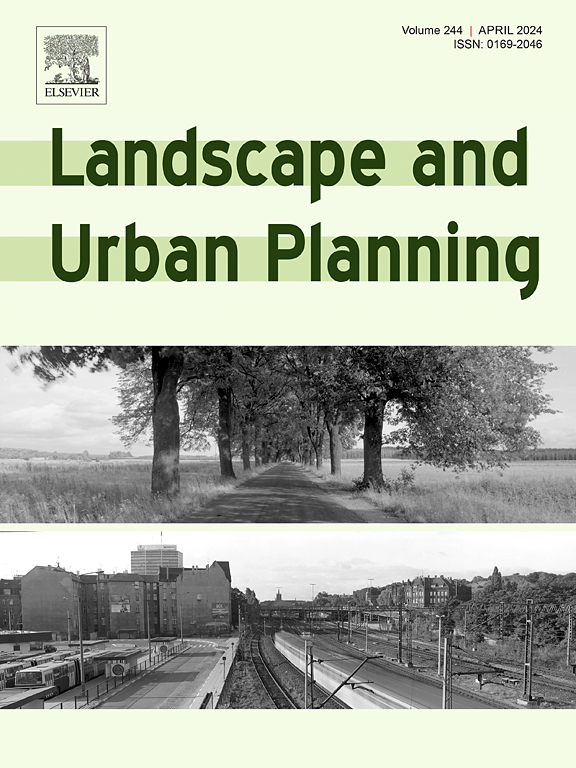城郊公园在提高高密度环境下城市绿地可达性方面的作用:环境正义视角
IF 7.9
1区 环境科学与生态学
Q1 ECOLOGY
引用次数: 0
摘要
近年来,城市绿地发展越来越重视城郊公园,但人们对城郊公园如何调节城市绿地的整体可达性以及如何促进环境正义却知之甚少,尤其是在高密度城市。为填补这一空白,本研究考察了 2000 年至 2020 年间香港不同社会群体的城市绿地整体可达性、公共停车设施的调节作用以及对这些作用的异质性和动态感知。研究结果显示,私人公园和公共绿地极大地重塑了不同时间集水区的城市绿地可达性模式,缓解甚至逆转了城市核心和边缘地区之间的差距。至于公共停车设施的调节作用,尽管不平等现象总体上呈减少趋势,但近年来城市地区之间的不平等现象却有所加剧。研究结果进一步揭示了公共停车设施为不同人群和社区带来的不同益处。妇女、老年人、低收入群体、高学历群体和少数族裔往往从公用事业中获益较少,而儿童和当地居民则受益更多。人口较多的家庭和核心家庭越来越依赖公用事业单位,而拥有住房优势(面积较大和拥有住房)的家庭也能享受到更多好处。值得注意的是,社会经济条件较差的社区和老龄化社区从公用事业单位获得的好处较少,而且越来越少。这项研究提供了全面的证据,有助于人们更好地理解城郊公园和城市公园之间的关系及其对环境正义的影响,从而更好地为以公平为导向的城市公园规划和决策提供信息。本文章由计算机程序翻译,如有差异,请以英文原文为准。
The role of peri-urban parks in enhancing urban green spaces accessibility in high-density contexts: An environmental justice perspective
Recent years have seen an increasing emphasis on peri-urban parks (PUPs) in urban green spaces (UGS) development, However, little is known about how PUPs moderate overall UGS accessibility and contribute to environmental justice, particularly for high-density cities. To address this salient gap, the present study examines the overall urban green space accessibility, the moderating effects of PUPs, and the heterogeneous and dynamic perception of these effects across diverse social groups in Hong Kong between 2000 and 2020. The results demonstrate that PUPs significantly reshape the UGS accessibility pattern across different time catchments, manifested by mitigating or even reversing the disparity between urban core and peripheral areas. For the moderating effect of PUPs, despite the general trend of reduced inequalities, recent years have witnessed an increase in the inequalities between urban districts. The findings further reveal the diverse benefits derived from PUPs for different population groups and neighborhoods. Women, the elderly, low-income groups, highly educated groups, and ethnic minorities tend to benefit less from PUPs, while children and local residents experience greater advantages. Larger households and nuclear family households have increasingly relied on PUPs, while households with housing advantages (larger size and homeownership) also enjoy more significant benefits. Notably, socio-economically disadvantaged and aging neighborhoods have experienced less and diminishing benefits from PUPs. This research offers comprehensive evidence to enhance the understanding of the relationship between peri-urban and urban parks and their impact on environmental justice, thus better informing equity-orientated UGS planning and policy-making.
求助全文
通过发布文献求助,成功后即可免费获取论文全文。
去求助
来源期刊

Landscape and Urban Planning
环境科学-生态学
CiteScore
15.20
自引率
6.60%
发文量
232
审稿时长
6 months
期刊介绍:
Landscape and Urban Planning is an international journal that aims to enhance our understanding of landscapes and promote sustainable solutions for landscape change. The journal focuses on landscapes as complex social-ecological systems that encompass various spatial and temporal dimensions. These landscapes possess aesthetic, natural, and cultural qualities that are valued by individuals in different ways, leading to actions that alter the landscape. With increasing urbanization and the need for ecological and cultural sensitivity at various scales, a multidisciplinary approach is necessary to comprehend and align social and ecological values for landscape sustainability. The journal believes that combining landscape science with planning and design can yield positive outcomes for both people and nature.
 求助内容:
求助内容: 应助结果提醒方式:
应助结果提醒方式:


